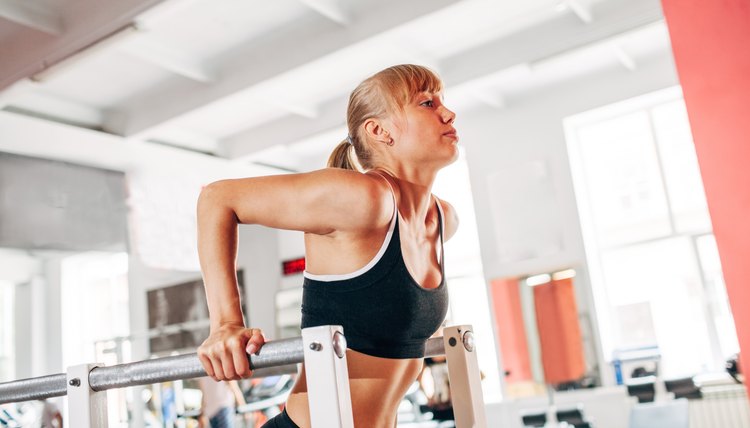Chest Dips: How Effective Are Dips? What Muscles are Worked?

To build a strong and defined chest, you don't need dumbbells or barbells. One of the best ways to increase upper-body strength, while creating a more muscular chest and arms, can be done with only your bodyweight by doing dips. Chest dips, though challenging for beginners, stimulate both the pectoralis major and minor, as well as the upper arms/triceps muscles, like no other exercise — making them a very effective bodyweight exercise for building muscle and bodybuilding.
Two Dip Exercises
Dips are one of the premier chest exercises and can be executed in two different styles. Each style targets the muscles of the chest and triceps differently. Performing dips with an upright torso targets more of your triceps, these are tricep dips. While leaning your torso forward during the exercise targets your chest, which is a chest dip.
Dps — both varieties — are performed on a dip bar or dip station, which is a set of parallel bars. To perform the exercise with proper form, grab the handles of the dip bar with your hands, palms facing your body. Your arms should be straight and your shoulders should in line with your hands. Bend your knees toward your hips, created a 90-degree angle. If the goal is to hit more of your chest, slightly lean forward, or keep your chest upright to target more of your triceps. This will be your starting position.
To begin the exercise, lower your body by bending your elbows. As you lower your body, your elbows should slightly flare out to the side. Once you feel a stretch in your chest or triceps, push your body back up until your arms are straight again. Perform four sets of six to 10 repetitions, or reps. To make it easier, think of it as the same range of motion as a pull up but moving down instead of up/
What are the benefits of dips?
Bodyweight dips are an essential strength training exercise on most workout routines and for good reason. The muscles of your chest perform more actions than pressing the weight off your chest or pushing your chest off the ground during push-ups. Hitting the different angles at which your chest muscles can move is vital to building more strength and definition.
Dips allow you to hit a wider breadth of your chest musculature. Unlike the bench press or even push-ups, dips enable you to hit the outer portion of your pectoral muscles far easier. Because dips activate less of the anterior deltoid muscle of your shoulder, when you perform dips, you force your pecs to work harder to push your back up.
However, dips are not an isolation exercise. They’re highly effective at building muscle groups such as the upper-body, but they also force you to engage your core — in this case, your abs, glutes and low back— so that you maintain proper posture as you descend into the bottom position and ascend back to the starting position. This makes it an effective exercise for most lifters.
Progressing Dips
Dips aren’t an exercise that most beginners will be able to perform on their first day. It requires not only significant strength to push your entire body weight up, but you must also have strong stabilizer muscles in your shoulders, upper back and core.
For beginners, you can perform dips on a dip machine, or do bench dips. These allow you the ability to use weight as a counterbalance and make your reps easier. As you get stronger with the assistance machine, you’ll be able to decrease weight until you’re able to perform a dip with only your bodyweight.
Once you’re able to perform 10 to 12 reps of dips in one set with only your bodyweight, you’ll be ready to add resistance via a dip belt. Start slow with weighted dips, adding only 10 pounds at first, and perform three sets of six to eight reps with the added weight plates. You can also do ring dips which are much harder due to the balance needed to do them.
Writer Bio
Eric Bach is a personal trainer, author of The Power Primer, and fitness business consultant in Denver, Colorado. His passion is simplifying fitness, helping clients get great results through the ruthless execution of the basics. Find out more on his website Bach Performance, or hang out on Facebook.
